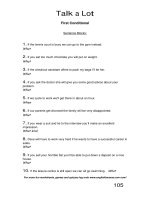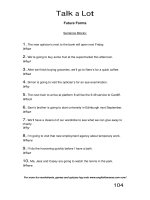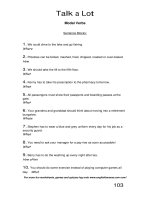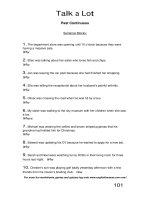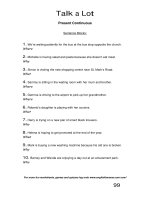talk a lot elementary book 3 assessment methods tests and examination
Bạn đang xem bản rút gọn của tài liệu. Xem và tải ngay bản đầy đủ của tài liệu tại đây (19.21 MB, 22 trang )
Talk a Lot
General Information
Assessment Methods, Tests, and Examination
The overall course mark for each student is reached by continuous assessment and an end of
course oral examination. Individual students are monitored throughout the course and their
progress recorded in a number of different ways. The aim of using continuous assessment is
to encourage students to work hard in every lesson – because every lesson counts and effort
is rewarded along with accuracy – and to work hard at home, e.g. learning the vocabulary
words each week.
Each student gets a combined mark out of 80 for each lesson which is based on the following:
•
•
•
•
vocabulary test:
lesson test:
student’s lesson mark – accuracy:
student’s lesson mark – effort:
maximum of 20 marks
maximum of 40 marks
maximum of 10 marks
maximum of 10 marks
•
total lesson mark:
maximum of 80 marks
The lesson marks are added together on the individual Student Course Reports as the course
progresses (see p.1.12 for a sample completed report, and p.1.11 for a blank template).
Students don’t have access to their lesson marks as they are added together, but they do see
their marks for the vocabulary and lesson tests, as well as getting feedback on these tests
and on their general performance each week.
Teachers should award marks out of 10 to each student for every lesson based on the level of
their achievement during the lesson (accuracy) and their commitment during the lesson
(effort). It goes without saying that teachers should strive to be wholly objective and not give
in to favouritism when awarding these marks.
Over the ten lessons all of the lesson marks are added together to give an individual total for
each student, to which is added the score from their final exam. This gives each student a
grade for the whole course, ranging from A to U (ungraded fail):
•
maximum lesson mark of 80 x 10 = 800 marks +
•
maximum final exam mark of 100 =
•
maximum course mark of 900 marks
Grade system:
Achievement:
Grade A = 800-900 marks
Grade B = 650-800 marks
Grade C = 550-650 marks
Grade D = 400-550 marks
Grade E = 250-400 marks
Grade U = less than 250 marks
First Class
Very Good
Good
Fair Pass
Pass
Fail
Grades A-E are passes. Grade U is ungraded and means that the student has failed the
course. The student’s grade is recorded on their course certificate, for example:
For more fun worksheets, games and quizzes log onto www.englishbanana.com now!
1.6
Talk a Lot
General Information
Assessment Methods, Tests, and Examination
“Grade: A”
“Achievement: First Class”
On p.1.12 you will find a sample completed course report for an above-average student, to
give you an idea of how the marking on the course report works.
You could use one of the course certificate templates from this book (see pages 1.26-1.27),
or create your own.
Lesson Assessment
During pair and group work the teacher monitors the students, checking and correcting
grammar and vocabulary where necessary, e.g. during discussion question and role play
rehearsals. In all free practice or word focus work the teacher should keep referring students
back to the grammar that is being learned in the sentence focus activities, for example if a
student says: “What you want?”, remind them that: “You must have a verb after a whquestion.” In this way the free practice and word focus work will help to consolidate what is
being learned during the more structured practice of forming the sentence blocks, and
studying sentence stress and the techniques of connected speech.
Written homework based on the topics and activities from each lesson could be given,
checked and marked by the teacher. However, written work must be kept to a minimum
during the lesson and students should not to write out full sentence blocks. This is Talk a Lot,
after all! The students may instinctively begin to write down the starting sentences from the
board, or make notes about the sentence blocks, but discourage this because it is a waste of
lesson time in which they have a valuable opportunity to talk in English. The Talk a Lot
method encourages students to use their memories as a learning tool and to activate the
grammar that they already know when they join the course. When a student writes down
the sentence blocks, they give full permission to their memory to forget this
information, since they know it is safely recorded somewhere. Without the safety net of
pen and paper students have to challenge themselves to work harder to make the sentence
blocks (which are, after all, simply question forms and answers, based around individual verb
forms). The time for writing out sentence blocks is at home, where students can write to their
hearts’ content! They also get a chance to see full sentence blocks in written form when they
do the lesson test – once per lesson. As we have seen, the Talk a Lot certificate is based on
marks gained during continuous assessment along with a final oral exam at the end of the
course. Lesson assessment also includes more formal testing with regular vocabulary tests
and lesson tests, the marks from which are added to each student’s running total of marks.
The teacher keeps track of each student’s progress by adding the results of their tests and
other marks to their individual Student Course Report.
Vocabulary Tests
All Talk a Lot tests should be run in exam conditions, with folders and dictionaries closed, no
talking, and no copying. The vocabulary test could be held near the beginning of the lesson,
as a way of quietening students down and getting them into study mode. We recommend that
the teacher runs the vocabulary and lesson tests in the same positions during the lessons
each time so as to give a sense of structure and routine to the tests which can be helpful for
For more fun worksheets, games and quizzes log onto www.englishbanana.com now!
1.7
Talk a Lot
General Information
Assessment Methods, Tests, and Examination
students. Teachers should try to mark the vocabulary tests during the lesson break and give
students their results in the same lesson. The teacher keeps a record of each student’s
scores on their Student Course Report and measures progress made, as well as spending
time during and between lessons addressing issues with individual students. There is a blank
Vocabulary Test pro-forma on p.1.13, so that you (and your students) can build your own
vocabulary tests.
Lesson Tests
The primary aim of the regular lesson test is to consolidate the work done during the previous
lesson. If you run this test immediately after the break it will help to settle students down and
get their minds focused again on learning English. Set a time limit of no more than 25 minutes
and stick to it. As with the vocabulary tests, the aim of the lesson test is to check students’
progress and both identify weaker students who may need extra support, e.g. help with
making the sentence blocks, and identify stronger students who may need a greater
challenge during lessons. For example, to maximise the effect of pair work the teacher could
pair a stronger student with a weaker student.
Lesson tests are marked by the teacher after the lesson and the results given to students at
the beginning of the next lesson, when there is time for a brief discussion of incorrect answers
and other points raised by the test. The results from both tests enable the teacher to see not
only who is paying attention during lessons, e.g. when making the sentence blocks, but also
who is working at home: learning the vocabulary words, both meanings and spellings, and
writing out sentence blocks.
At their discretion, a teacher may allow students who have missed a lesson to catch up on
course marks by taking both tests at another time, e.g. after the present lesson. Or the
teacher may decide that the student has missed the lesson and so cannot catch up on the
marks, a scenario that will affect their final course score. However, if the latter applies the
teacher should give the student in question the lesson materials to study at home in their own
time, so that they don’t miss out on course content.
Note: students can’t do a Vocabulary Test or Lesson Test during their first Talk a Lot lesson,
because there is no preceding unit, and they haven’t had anything to prepare. The
Vocabulary Test and Lesson Test for the first lesson’s topic can be taken in week 11 (revision
week), and the scores added to the students’ lesson 1 scores on the course reports (in the
boxes marked in bold).
Verb Forms Practice
These pages can be introduced by the teacher as extra worksheets at any time during the
course if students are having problems with sentence blocks based on a particular verb form,
or if they need more focused verb forms practice. A follow up activity would be for students to
imagine their own sentence blocks based on particular verb forms, e.g. the teacher asks
students to work in pairs and make four new sentence blocks using present perfect form –
orally, without writing anything down.
In general, it’s better for students to use a variety of different verb forms in a normal lesson,
rather than studying a different verb form each lesson, because if a student misses one
For more fun worksheets, games and quizzes log onto www.englishbanana.com now!
1.8
Talk a Lot
General Information
Assessment Methods, Tests, and Examination
lesson they won’t have missed out on studying a complete verb form.
End of Course Oral Examination
General Notes on the Examination
The Talk a Lot end of course exam is a one to one oral examination with the teacher reading
the questions and the student answering. The exam should last for a maximum of 20 minutes.
The exam is recorded onto tape and marked by the teacher afterwards. The results are added
to the student’s individual Student Course Report and then their overall course score and final
grade can be calculated, which are then added to the student’s certificate.
At no time should the student see the examination paper, whether before, during or after the
examination. Nor should the student write down anything during the exam. The teacher writes
the starting sentence and question word (printed in bold) on the board for each sentence
block question.
If you are following the course in either Book 1 or Book 2, you could use the examination
provided for the book you are using. (See p.1.14 for Examination #1 from Book 1 and p.1.18
for Examination #2 from Book 2.) If you have built your own course by using a variety of units
from Books 1-3, you could build your own examination as well, by taking questions from each
topic that you have used. Use the ready-made examinations from Books 1 and 2 to guide you
when devising the questions.
During the examination the teacher should not prompt the student for answers or help them in
any way, apart from to explain the instructions so that the student understands what they
have to do. Students may not use a dictionary during this examination.
At the end of the course the teacher could give a prize to the student (or students) with:
•
•
•
•
•
the best course score overall
the best vocabulary test grades overall
the best lesson test grades overall
the best attendance record
the most improved student (comparing the beginning with the end of the course)
Marking Guide
There are four kinds of question that form the examination:
1. Make sentence blocks (e.g. questions 1, 5, 9, and 13 in Examination #2)
The maximum score is 8 marks. Students score one mark for each fully correct line, with
correct intonation and sentence stress, and one mark for naming the correct verb form.
Students get only half a mark if the intonation and/or sentence stress of a line is incorrect. In
the last two lines of each sentence block the answers will vary as students have to change
part of the original information to produce a negative answer. Accept any answer that is
grammatically correct and makes sense within the given context.
For more fun worksheets, games and quizzes log onto www.englishbanana.com now!
1.9
Talk a Lot
General Information
Assessment Methods, Tests, and Examination
Don’t penalise students for making contractions, or not making them. For example, if the
answer on the examination paper says “No, he doesn’t”, but the student says “No, he does
not”, don’t mark them down. It is still an accurate answer.
2. Answer discussion questions (e.g. questions 3, 7, 10 and 14 in Examination #2)
Students can score up to a maximum of 4 points for each question based on the following
criteria:
The student should answer the question and speak for approximately 1 minute:
4 marks:
3 marks:
2 marks:
1 mark:
0 marks:
the student produces sentences which are completely or almost completely
correct in terms of grammar, pronunciation, intonation, and sentence stress.
There are between 0-2 errors. Excellent use of vocabulary and interesting
subject matter
the student produces sentences which are good in terms of grammar,
pronunciation, intonation, and sentence stress, but there are between 3-4
errors. Good use of vocabulary
the student produces sentences which can be understood in terms of
grammar, pronunciation, intonation, and sentence stress, but there are many
errors
the student attempts to answer the question, but not using full sentences nor
correct grammar, pronunciation, intonation, and sentence stress. Part of their
answer can be clearly understood, but there are many errors
the student has not attempted the question or the answer is incoherent
The teacher should make a note in the box provided of several examples of the student’s
performance, including errors as well as correct structures.
3. State ten vocabulary words on a given topic (e.g. questions 4, 6, 11 and 15 in
Examination #2)
When students have to list ten vocabulary words, the teacher could keep a tally in the box
provided, e.g. IIII IIII … Give a half mark in the event of wrong word stress or incorrect
intonation and/or pronunciation. When stating ten different vocabulary words the student
cannot include the example word which is given in the question.
4. Answer discussion word questions (e.g. questions 2, 8, 12 and 16 in Examination #2)
The answers and marks for these questions are provided on the examination paper. Give a
half mark in the event of wrong word stress or incorrect intonation and/or pronunciation.
(Note: see p.1.22 for a sample examination paper that has been completed by the teacher
during a Talk a Lot oral examination with a pre-intermediate level student.)
For more fun worksheets, games and quizzes log onto www.englishbanana.com now!
1.10
Talk a Lot
Name: ____________________________________
Lesson
1.
Vocabulary
Test /20
Lesson Test
/40
*
*
Lesson Mark –
Accuracy /10
Lesson Mark –
Effort /10
Start Date: ___________
Total Marks
/80
Class: ___________
Teacher’s Comments
2.
3.
4.
5.
6.
7.
8.
9.
10.
Total Lesson
Mark /800
Final Exam
/100
Course Total
Mark /900
Course Final
Grade
Attendance
/30 GLH
* score from Lesson 10 test
ACHIEVEMENT:
Attendance
as a %
%
1.11
Talk a Lot
ST
Name: MARIA GOMEZ
Lesson
Start Date: 1
MAY ’09
Class: 40-A
Vocabulary
Test /20
Lesson Test
/40
Lesson Mark –
Accuracy /10
Lesson Mark –
Effort /10
Total Marks
/80
Teacher’s Comments
20*
32*
6
8
66
[Write short general comments regarding the student’s
test scores, achievement, and commitment during each
16
17
34
31
7
8
8
9
65
65
lesson, as well as their progress on the course, and
notes about any relevant incidents. For example:]
4. Weather
18
25
6
6
55
5. Animals
16
30
0**
0**
46
18
17
18
16
19
32
35
36
36
35
7
7
8
8
8
8
9
8
9
9
65
68
70
69
71
1. Crime
2. Sport
3. Music
6. Cars
7. The Human
Body
8. Colours and
Numbers
9. Life Events
10. Nature
Total Lesson
Mark /800
[etc. …]
640
* score from “Nature” test
** Maria missed this lesson
79
Final Exam
/100
Course Total
Mark /900
719
Course Final
Grade
B
Attendance
/30 GLH
Maria made a good contribution to sentence block
building and worked hard throughout this lesson…
Maria’s energy level was lower than usual. She
scored lower than expected on the “Music” L/Test…
Maria was absent today due to family illness. She
will take the “Weather” tests before next lesson…
27
Attendance
as a %
90%
ACHIEVEMENT: VERY GOOD
1.12
Talk a Lot
Topic: __________________
Vocabulary Test
First Language
English
1. _______________________
_______________________
2. _______________________
_______________________
3. _______________________
_______________________
4. _______________________
_______________________
5. _______________________
_______________________
6. _______________________
_______________________
7. _______________________
_______________________
8. _______________________
_______________________
9. _______________________
_______________________
10. ______________________
_______________________
11. ______________________
_______________________
12. ______________________
_______________________
13. ______________________
_______________________
14. ______________________
_______________________
15. ______________________
_______________________
16. ______________________
_______________________
17. ______________________
_______________________
18. ______________________
_______________________
19. ______________________
_______________________
20. ______________________
_______________________
For more fun worksheets, games and quizzes log onto www.englishbanana.com now!
1.13
Talk a Lot
End of Course Oral Examination #1 (Page 1)
Name: ___________________________ Date: __________ Total # Marks: __________ /100
Question 1
Form the sentence block:
Peter walks two kilometres to his office every day.
Who walks two kilometres to his office every day?
Peter does.
Does Peter walk two kilometres to his office every day?
Yes, he does.
Does Jeff walk two kilometres to his office every day?
(Answers will vary)
No, he doesn’t. Jeff doesn’t walk two kilometres to his office every day.
(Answers will vary)
Which verb form is used in the starting sentence? (Answer: present simple)
(8 marks)
Question 2
Tell me ten different members of a family, e.g. mother.
See p.68 (Book 1) for a list of family words. (10 marks)
Question 3
Describe your dream home. Where would you like to live if you could live anywhere? Talk
about location, type of home, number of rooms, furniture, swimming pool, garden, staff, etc.
(4 marks)
Question 4
Put these clothes words into alphabetical order: trainers, coat, scarf, dress, belt, sock.
Answer: belt, coat, dress, scarf, sock, trainers.
(1 mark)
For more fun worksheets, games and quizzes log onto www.englishbanana.com now!
1.14
Talk a Lot
End of Course Oral Examination #1 (Page 2)
Question 5
Form the sentence block:
If you ask the doctor she will give you some good advice about your problem.
Who will give me some good advice about my problem if I ask her?
The doctor will.
Will the doctor give me some good advice about my problem if I ask her?
Yes, she will.
Will the receptionist give me some good advice about my problem if I ask her?
(Answers will vary)
No, they won’t. The receptionist won’t give you some good advice about your
problem if you ask them.
(Answers will vary)
Which verb form is used in the starting sentence? (Answer: first conditional)
(8 marks)
Question 6
What is your favourite food? Why do you like it? How often do you eat it? What is your
favourite drink? Why?
(4 marks)
Question 7
Tell me ten different jobs, e.g. doctor.
See p.64 (Book 1) for a list of health words. (10 marks)
Question 8
Tell me two forms of transport that have:
a) 1 syllable
c) 3 syllables
b) 2 syllables
Answers will vary. See p.66 (Book 1) for a list of transport words. Suggested answers: a) bus,
train; b) canoe, ferry; c) motorbike, aeroplane. (6 marks)
For more fun worksheets, games and quizzes log onto www.englishbanana.com now!
1.15
Talk a Lot
End of Course Oral Examination #1 (Page 3)
Question 9
Form the sentence block:
After we finish buying groceries, we’ll go to Nero's for a quick coffee.
Where will we go for a quick coffee after we finish buying groceries?
To Nero’s.
Will we go to Nero’s for a quick coffee after we finish buying groceries?
Yes, we will.
Will we go to Bob’s Coffee Shop for a quick coffee after we finish buying groceries?
(Answers will vary)
No, we won’t. We won’t go to Bob’s Coffee Shop for a quick coffee after we finish
buying groceries
(Answers will vary)
Which verb form is used in the starting sentence? (Answer: future forms)
(8 marks)
Question 10
Which family word has a different word stress from the others? Why?
family, fiancé, granddaughter
Answer: The word fiancé has a different word stress because the strong stress falls on the
second syllable, while in family and granddaughter the strong stress falls on the first syllable.
(1 mark)
Question 11
Tell me about a memorable holiday. Where was it? Who did you go with? Why did you decide
to go there? What happened?
(4 marks)
Question 12
Tell me ten different modes of transport, e.g. bicycle.
See p.66 (Book 1) for a list of transport words.
(10 marks)
For more fun worksheets, games and quizzes log onto www.englishbanana.com now!
1.16
Talk a Lot
End of Course Oral Examination #1 (Page 4)
Question 13
Form the sentence block:
I have seen Macbeth at this theatre five times.
How many times have you seen Macbeth at this theatre?
Five times.
Have you seen Macbeth at this theatre five times?
Yes, I have.
Have you seen Macbeth at this theatre six times?
(Answers will vary)
No, I haven’t. I haven’t seen Macbeth at this theatre six times.
(Answers will vary)
Which verb form is used in the starting sentence? (Answer: present perfect)
(8 marks)
Question 14
If you were given £3,000 to spend only on clothes and shoes, what would you buy and where
would you go shopping?
(4 marks)
Question 15
Tell me ten different kinds of food, e.g. pasta.
See p.60 (Book 1) for a list of food words.
(10 marks)
Question 16
Which person…
a) can fix a leaky pipe?
c) sells flowers?
b) can help you sell your house?
d) wears clothes for a living?
Answers: a) plumber, b) estate agent, c) florist, d) model
(4 marks)
For more fun worksheets, games and quizzes log onto www.englishbanana.com now!
1.17
Talk a Lot
End of Course Oral Examination #2 (Page 1)
Name: ___________________________ Date: __________ Total # Marks: __________ /100
Question 1
Form the sentence block:
When I went to Australia I saw some wild kangaroos.
What did you see when you went to Australia?
Some wild kangaroos.
Did you see some wild kangaroos when you went to Australia?
Yes, I did.
Did you see some wild elephants when you went to Australia?
(Answers will vary)
No, I didn’t. I didn’t see any wild elephants when I went to Australia.
(Answers will vary)
Which verb form is used in the starting sentence? (Answer: past simple)
(8 marks)
Question 2
Which weather word has a different word stress from the others? Why?
umbrella, prediction, hurricane
Answer: the word hurricane has a different word stress because the strong stress falls on the
first syllable, while in umbrella and prediction the strong stress falls on the second syllable.
(1 mark)
Question 3
Tell me about the different times when you listen to music during the day, from when you
wake up until you go to bed.
(4 marks)
Question 4
Tell me ten different things that you could find in the countryside, e.g. river.
See p.72 (Book 2) for a list of nature words. (10 marks)
For more fun worksheets, games and quizzes log onto www.englishbanana.com now!
1.18
Talk a Lot
End of Course Oral Examination #2 (Page 2)
Question 5
Form the sentence block:
You should look in your mirrors before indicating.
Where should I look before indicating?
In your mirrors.
Should I look in my mirrors before indicating?
Yes, you should.
Should I look in the glovebox before indicating?
(Answers will vary)
No, you shouldn’t. You shouldn’t look in the glovebox before indicating.
(Answers will vary)
Which verb form is used in the starting sentence? (Answer: modal verbs)
(8 marks)
Question 6
Tell me five different musical instruments, and five different kinds of music.
See p.58 (Book 2) for a list of music words. (10 marks)
Question 7
Tell me about the seasons in your country. How do the countryside, weather, and climate
change throughout the year? How do you have to change the way you live?
(4 marks)
Question 8
Put these life events into alphabetical order: marriage, birth, redundancy, engagement,
graduation, employment.
Answer: birth, employment, engagement, graduation, marriage, redundancy.
(1 mark)
For more fun worksheets, games and quizzes log onto www.englishbanana.com now!
1.19
Talk a Lot
End of Course Oral Examination #2 (Page 3)
Question 9
Form the sentence block:
Jason was running faster than usual because he wanted to beat his
personal best.
Who was running faster than usual because they wanted to beat their personal best?
Jason was.
Was Jason running faster than usual because he wanted to beat his personal best?
Yes, he was.
Was Mark running faster than usual because he wanted to beat his personal best?
(Answers will vary)
No, he wasn’t. Mark wasn’t running faster than usual because he wanted to beat
his personal best.
(Answers will vary)
Which verb form is used in the starting sentence? (Answer: past continuous)
(8 marks)
Question 10
What was the happiest time in your life? Why? What are you looking forward to the most?
Why? What do you fear the most? Why?
(4 marks)
Question 11
Tell me ten different colours, e.g. blue.
See p.68 (Book 2) for a list of colours.
(10 marks)
Question 12
Name an animal that…
a) can spin a web.
c) can swim underwater.
b) swings from tree to tree.
d) carries its home on its back.
Answers will vary. Suggested answers: a) spider, b) monkey, c) whale, d) snail / tortoise.
(4 marks)
For more fun worksheets, games and quizzes log onto www.englishbanana.com now!
1.20
Talk a Lot
End of Course Oral Examination #2 (Page 4)
Question 13
Form the sentence block:
Veronica’s had her nose pierced at that new salon on the corner of Maitland
Street.
What has Veronica had pierced at that new salon on the corner of Maitland Street?
Her nose.
Has Veronica had her nose pierced at that new salon on the corner of Maitland
Street?
Yes, she has.
Has Veronica had her ears pierced at that new salon on the corner of Maitland
Street? (Answers will vary)
No, she hasn’t. Veronica hasn’t had her ears pierced at that new salon on the
corner of Maitland Street. (Answers will vary)
Which verb form is used in the starting sentence? (Answer: present perfect)
(8 marks)
Question 14
Would capital punishment solve the problem of prison overcrowding? Why? / Why not?
(4 marks)
Question 15
Tell me ten different sports, e.g. rugby.
See p.56 (Book 2) for a list of sports.
(10 marks)
Question 16
Tell me two different numbers that have:
a) 1 syllable
c) 3 syllables
b) 2 syllables
Answers will vary. See p.68 (Book 2) for a list of numbers. Suggested answers: a) one, two;
b) fourteen, twenty; c) eleven, seventeen .
(6 marks)
For more fun worksheets, games and quizzes log onto www.englishbanana.com now!
1.21
Talk a Lot
Elementary Level
Certificate in Spoken English
This is to certify that:
______________________________________________________________
has completed a _________ week Talk a Lot course in spoken English at this
establishment and has achieved the following grade:
Grade: _________
Achievement: _________
Date: _________
Candidate Number: _________
Signed: _________________________ (Course Teacher) Date: _________
Signed: _________________________ (Centre Manager) Date: _________
School Name and Address:
School Phone Number / Email Address / Website Address:
Talk a Lot
Elementary Level
Certificate in Spoken English
This is to certify that:
______________________________________________________________
has completed a _________ week Talk a Lot course in spoken English at this
establishment and has achieved the following grade:
Grade: _________
Achievement: _________
Subjects Covered:
9
9
9
9
9
9
Speaking and Listening
Pronunciation
Grammar
Vocabulary
Word and Sentence Stress
Connected Speech
Date: _________
Candidate Number: _________
Signed: _________________________ (Course Teacher) Date: _________
Signed: _________________________ (Centre Manager) Date: _________
School Name and Address:
School Phone Number / Email Address / Website Address:




